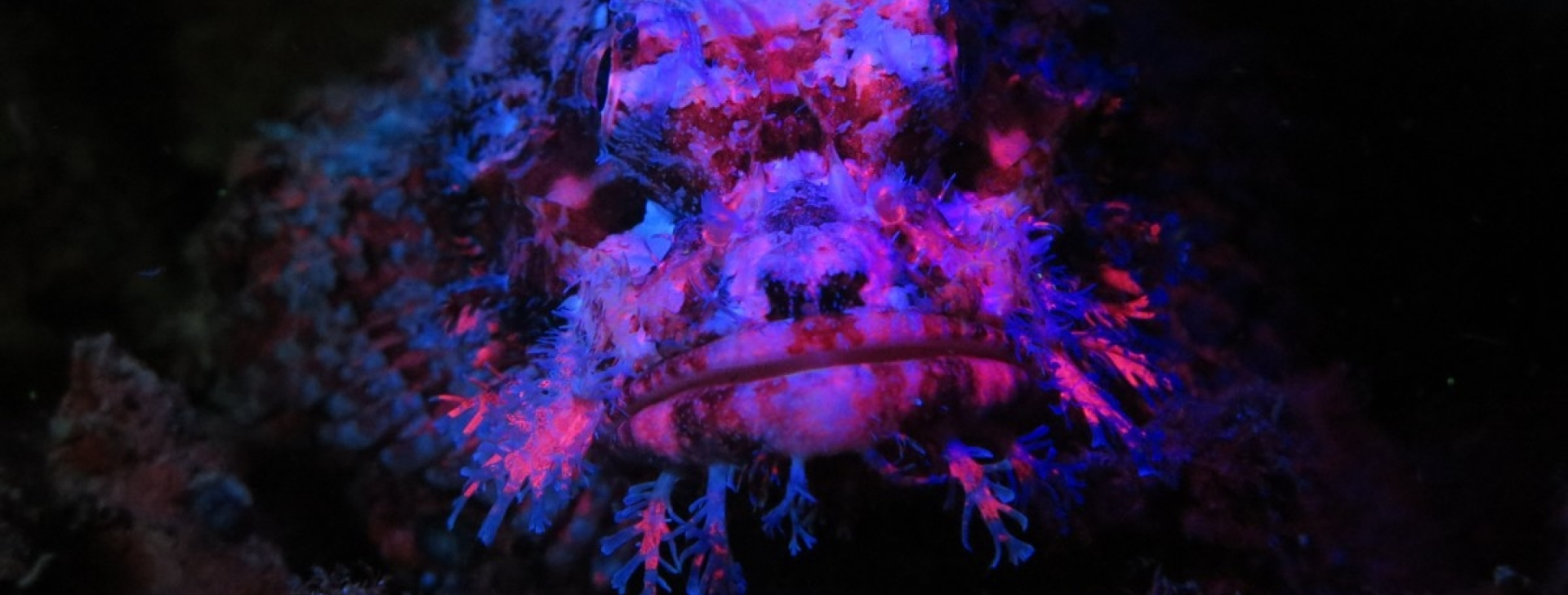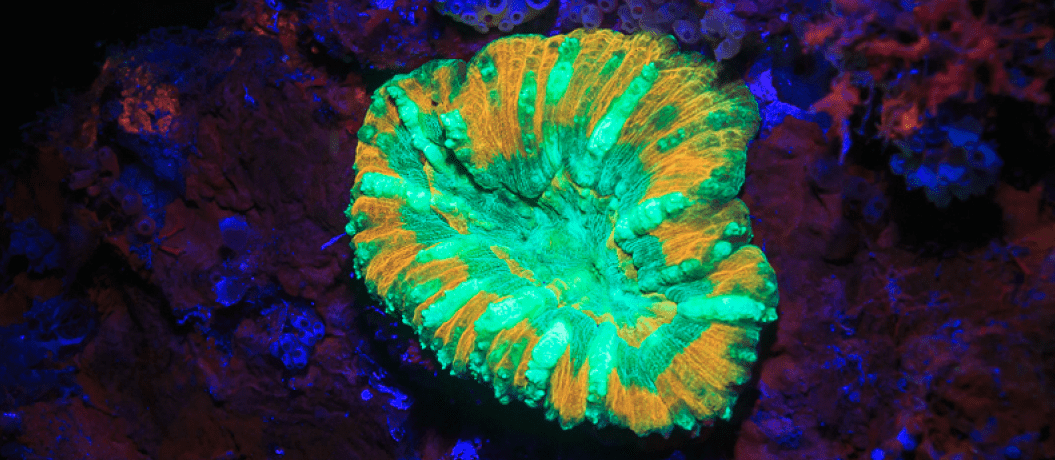
UV light, or ultraviolet light, is a type of electromagnetic radiation. UV wavelengths are shorter than visible light, so we cannot see them with the naked eye. While the sun produces UV light alongside visible light, ~95% of all UV rays from the sun get reflected off the water’s surface.
Once divers submerge themselves over just a couple of feet deep, no UV light is present, which is why coral reefs don’t regularly glow.
Certain materials and specimens absorb UV light and reflect it back as a fluorescent glow.
When UV light is applied to certain specimens, it stimulates excitation or the production of fluoro. As a material reflects back the absorbed UV light, it produces an incredible glowing effect along the ocean floor. However, UV light is very inefficient for producing this effect.
UV light exposure can lead to skin damage and temporary blindness in humans and animals, making UV light a less used light source than blue lights for underwater fluorescence photography.
UV-induced visible fluorescence is how photographers and scientists have documented natural underwater light shows since the fluorescent effect was first documented in the 1830s.
By the 1980s and 1990s, the noted marine biologist Dr. Charles Mazel contributed invaluable research about which wavelengths of light produce the highest spectral emissions in sea creatures. He found that while UV light made organisms fluoresce, blue light produced much brighter, more efficient, and more vivid displays of glowing colors.
The major downside of using UV light in fluorescence photography is how harsh it is on the eyes. Not only does UV light impair the vision of other divers, but it also can harm marine life.
Suppose a flash of UV light gets in your eyes mid-dive. In that case, you could experience white spots and temporary blindness. In some cases, divers have to end their expedition early as they wait for their vision to return to normal.
Divers wear sunglasses or barrier masks to help protect their eyes from UV rays. However, fish don’t have this same protection. Animals can get temporarily blinded or suffer permanent eye damage from long exposure to UV light. That’s why AWARE divers prefer blue light vs. UV light.
Blue light falls just before UV light on the electromagnetic spectrum. One difference between UV vs. blue light is our ability to see blue light.
Generally speaking, the longer the wavelength, the less energy is emitted. Blue light, or high-energy visible (HEV) light, has a longer wavelength than UV light, at around 450 to 490 nanometers.
The sun emits blue light alongside UV rays. However, blue light penetrates deeper into the ocean than UV light. Like UV light, blue light stimulates the production of fluoro in some sea creatures.
Blue light helps underwater specimens produce a remarkable fluorescent glow. Blue light gets absorbed by the specimen. After absorbing the blue light, the specimen emits it back as a bright display of other glowing colors of the visible spectrum.
Blue light has a relatively high-energy wavelength, allowing it to more efficiently stimulate excitation similarly to UV light, but it is still visible to the naked eye, making it less harsh on marine life and our eyesight.
LED torches are essential tools for fluorescence photographers that shine a beam of blue light to illuminate the corals and creatures below. Alternatively, fluorescence photographers use dichroic filters to adjust their camera flash to transmit blue light.
While blue light produces fluorescence, underwater photographers must use blue light protection, like barrier filters, to reduce glare and enhance the accuracy of their images.
Barrier filters offer blue light protection to divers and their fluorescent photographs. While shining LED lights on marine life can produce dazzling effects for stunning photos, it can cause vision impairment if you shine it in a diver’s eyes during an expedition.
Mask barrier filtersprotect the eyes of divers while improving the overall appearance of fluorescence emissions from marine specimens. Not only do barrier filters block out harsh glares, but they also provide color correction to allow viewers to experience the full display of outstanding colors.
Blue light is the superior choice when it comes to a decision between UV light vs. blue light. Studies by Dr. Charles Mazel and studies from the experts at FirediveGear continually show that blue light causes a more efficient emission effect and that blue light vs. UV light produces more exceptional photos.
UV light exposure is harsh on marine life, and creatures stunned by bright UV lights make an easy meal for predators. Meanwhile, most specimens that emit fluorescence also do so under blue light more dramatically. While there are some species that have slightly greater emission effects under UV light, it’s likely that you’ll have a VASTLY more illuminated diving experience using blue light vs. UV light.
Why Use Blue Light For Underwater Fluorescence Rather Than UV Light

If you have any questions, comments or suggestions – PLEASE don’t hesitate to contact us.